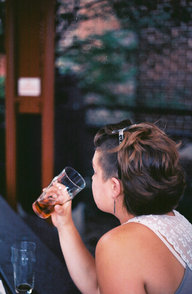Start 14-Day Trial Subscription
*No credit card required

Tea'ers For Beers
Brewing beer is not unlike steeping tea. The early steps in the brewing process, in fact, are identical to extracting flavors from tea leaves. A measured amount of grain enters near-boiling water for a prescribed period of time. Hops are added at precise moments during and after the boil, releasing their oils into the melange, too.
The extraction of sugar from grain and essential oils from hops makes beer unique among alcoholic beverages. Brewers often experiment with other types of steeping, too. Classic Belgian wheat beers contain coriander and orange peel. Some American stouts and porters contain coffee in the form of beans that are left to soak for a prolonged period. And come fall, shelves will be flooded with heavy-handed pie-spice beer.
The idea of beer and tea coming together in one glass is steadily gaining popularity in the Midwest. A few examples have had a loyal following for years while a runaway hit or two are helping ease the transition into cooler, more tea-like weather.
 I spoke with the brewers behind Minnesota and Wisconsin’s most popular tea beers to discover the inspiration and brewing techniques required to create a successful synergy of flavor.
I spoke with the brewers behind Minnesota and Wisconsin’s most popular tea beers to discover the inspiration and brewing techniques required to create a successful synergy of flavor.
In the doing-it-before-it-was-cool category is Milwaukee’s O-Gii beer. Nearly every creator mentioned homebrewing as a source of inspiration, and this was true in the case of brewer Kurt Mayes, who was once a chef at at Chinese restaurant. “I would drink lots of green tea...and thought that the tea kind of reminded me of hops. I wanted to make a high alcohol beer that was very easy to drink.” For those who have had O-Gii, Mayes clearly nailed it, as the beer defines “dangerously drinkable”.
In 2011, imperial witbier was novel, as was adding green tea to beer. The tea used comes from Rishi Tea, a local source, and is added at the end of the boil. Chamomile is added like a dry hop, at the very end of the brewing process.
Dangerous Man in Northeast Minneapolis also makes the wildly popular Red Rooibos, which possesses a far stronger tea flavor than any other tea beer I have ever experienced. Rob Miller, brewmaster, also describes using tea in homebrewing for intensity of flavor.
Rooibos is potent in its vanilla and earth notes, and the tea itself is sweet and mellow. Some varieties are nutty or spicy while others contain berry notes. It is not hard to imagine rooibos playing well with malt flavors, but balance is key, lest the tea beer become a glass of boozy tea. Miller uses a similar technique to Mayes: “The tea is steeped during the whirlpool for 10 minutes. We use a huge strainer bag and float it in the kettle. We use two pounds of rooibos per barrel of beer.”
Using the same variety of tea, but to a more restrained degree, is Oliphant Brewing in Somerset, Wisconsin. Brewers Matt Wallace and Trevor Wirtanen also took inspiration from their homebrewing days for their wwDMd imperial Belgian red ale. The beer, which also showcases hibiscus, pineapple and lychee, contains the earthiness of the tea, aromatics of the fruit and flower, plus the sweetness of an imperial-strength malt bill. The tea also adds additional red color to the glass, without becoming overly tannic, and major issue when using tea in beer.
The newcomer to the group comes from St. Paul’s Summit Brewing and was inspired by something totally different -- Star Trek. Brewer Nick Hempfer was watching Wrath of Kahn while brainstorming ideas for his first beer in Summit’s Unchained series. He was inspired by Captain Picard’s serious Earl Grey habit and British accent. The name? Make It So.
Sure, some of the beer’s extreme popularity could be chalked up to the Trekkie crowd, but the excellent relationship between Earl Grey and U.K. malts makes for a beer that is easy to drink, easy to pair, and widely appealing.
Other brewers were skeptical, though, and Hempfer was relegated to the pilot system with several varieties of tea from local supplier, Tea Source. “It was a fun partnership,” he says of narrowing down the specific type. Ultimately, after a few initial trials that were more like “tea with beer in it”, he was able to change the minds of even the most apprehensive drinkers.



